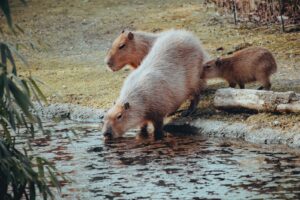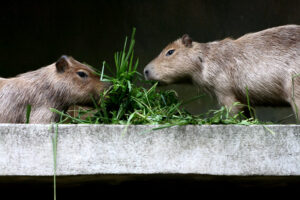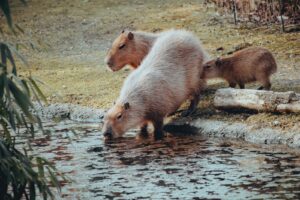Capybaras, the world’s largest rodents, are native to South America and inhabit countries like Brazil, Venezuela, Colombia, Argentina, and Uruguay. These remarkable creatures are highly adaptable, thriving in diverse environments from grasslands and marshes to dense forests and swamps. Capybaras are semi-aquatic animals, making them adept at both land and water habitats. Their unique adaptations enable them to be masters of their environment, blending seamlessly into their surroundings.
Social Structure and Behavior of Capybaras
In their natural habitat, capybaras form social groups known as herds, typically consisting of 10 to 30 individuals. These herds provide safety in numbers and enable efficient foraging and protection against predators. The social bonds within these groups are strong, with a clear hierarchy led by a dominant male. Capybaras are herbivores, primarily feeding on grasses, aquatic plants, and fruits. Their natural habitats offer a rich diversity of vegetation, ensuring a nutritious diet. Despite their large size, capybaras are gentle and peaceful, coexisting harmoniously with other animals in their ecosystem.
Adaptations for a Semi-Aquatic Lifestyle
Capybaras are exceptionally well-adapted to a semi-aquatic lifestyle. Their partially webbed feet and streamlined bodies allow them to navigate rivers, lakes, and wetlands effortlessly. Capybaras are excellent swimmers, often spending significant time in the water to regulate their body temperature and avoid overheating. Swimming is not just a fascinating trait but also a vital survival skill. They can stay submerged for up to five minutes, a capability that helps them evade predators and access food sources.
Size and Physical Characteristics of Capybaras
Capybaras are impressively large for rodents. They can reach lengths of 4 to 5 feet (1.2 to 1.5 meters) and weigh between 77 to 146 pounds (35 to 66 kilograms). Standing around 2 feet (60 centimeters) tall at the shoulder, their size is striking when compared to humans. Despite their size, capybaras are agile, capable of swift movement on land and in water. Their elongated limbs and powerful muscles facilitate navigation through various terrains with ease. While their size might seem intimidating, capybaras are known for their gentle and friendly nature.
Diet and Feeding Habits
Capybaras have a herbivorous diet, primarily consuming grasses, aquatic plants, and fruits. They are voracious eaters, consuming large quantities of plant matter daily to sustain their energy levels. Their sharp incisors and molars, along with strong jaw muscles, allow them to efficiently graze on tough vegetation. Capybaras also enjoy aquatic plants like water hyacinths and water lilies, thanks to their semi-aquatic nature. They are opportunistic feeders and may consume fruits and crops when available. Their specialized digestive system, featuring a large cecum, allows them to break down cellulose and extract nutrients from plant material.
Comparison with Guinea Pigs
Capybaras and guinea pigs, though both members of the rodent family, have distinct differences. Capybaras are significantly larger, reaching lengths of up to 5 feet and weighing between 77 to 146 pounds, while guinea pigs are much smaller, typically measuring 8 to 10 inches in length and weighing 1.5 to 2.6 pounds. Capybaras are semi-aquatic and prefer habitats near water bodies, whereas guinea pigs are terrestrial and prefer dry land. Capybaras are highly social and live in large herds, while guinea pigs are more solitary, often living in pairs or small groups. As pets, guinea pigs are more manageable due to their size and care requirements, whereas capybaras require specialized living conditions and diet.
Pros and Cons of Keeping Capybaras as Pets
Owning a capybara as a pet has its unique set of challenges and benefits:
Pros:
- Social Nature: Capybaras form strong bonds with their caretakers and thrive in social settings.
- Gentle Disposition: They are generally docile and affectionate.
- Unique Experience: Owning a capybara offers a one-of-a-kind pet experience.
Cons:
- Size and Space Requirements: Capybaras need ample space and access to water.
- Specialized Diet: They require a high-fiber diet and fresh vegetation.
- Legal and Permit Issues: Owning capybaras may require special permits and adherence to local regulations.
- Social Needs: They thrive in the company of their kind and may experience loneliness if kept alone.
- Maintenance and Care: Capybaras require regular grooming, dental care, and veterinary check-ups.
Capybaras in Popular Culture and Media
Capybaras have gained popularity on social media for their charming and amusing antics. Videos of capybaras enjoying spa sessions, interacting with other animals, and displaying playful behavior have captivated audiences worldwide. Their gentle and friendly nature shines through in these videos, showcasing their unique personalities and bringing joy to viewers.
Lifespan and Health
In the wild, capybaras typically live for about 8 to 10 years, while in captivity, with proper care, they can live up to 12 years or more. Factors contributing to their lifespan include diet, habitat, and overall health. In captivity, they benefit from consistent food supply, veterinary care, and protection from predators, contributing to their longevity.
Capybara Teeth and Bite Strength
Capybaras have continuously growing incisors that allow them to effectively graze on tough vegetation. These incisors are constantly worn down through grazing, ensuring they remain functional. Their molars are used for grinding and chewing plant matter, aiding in their herbivorous diet. Capybaras’ dental adaptations are crucial for their survival, enabling them to efficiently process fibrous plant material.
Capybaras are truly fascinating creatures, with unique adaptations and behaviors that make them stand out in the animal kingdom. Their gentle nature, social behavior, and remarkable swimming abilities contribute to their charm and appeal. Whether in the wild or as pets, capybaras continue to captivate and inspire admiration and respect.
Sources:
- National Geographic. (n.d.). Capybara. Retrieved from National Geographic
- San Diego Zoo. (n.d.). Capybara. Retrieved from San Diego Zoo
- The Rainforest Foundation. (n.d.). Capybara. Retrieved from The Rainforest Foundation




